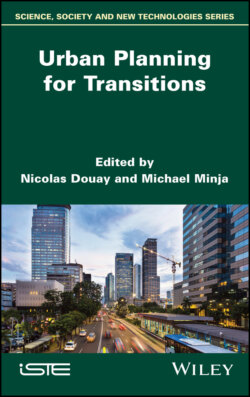Urban Planning for Transitions

Реклама. ООО «ЛитРес», ИНН: 7719571260.
Оглавление
Группа авторов. Urban Planning for Transitions
Contents
List of Illustrations
List of Tables
Guide
Pages
Urban Planning for Transitions
Introduction
1. Rotterdam Resilience Strategy, Rotterdam. 1.1. Introduction
1.2. Context and background
1.3. Rotterdam Resilience Strategy – Ready for the 21st Century. 1.3.1. Methodology
1.3.2. Rotterdam Resilience Strategy – Goals, stakeholders
1.3.3. Concrete resilient initiatives and programs
1.4. Conclusion
1.4. References
2. Sustainable Florianópolis Action Plan, Santa Catarina. 2.1. Introduction
2.2. Context: Florianópolis’ background
2.3. The Sustainable Florianópolis Plan of Action. 2.3.1. A comprehensive analysis of the city
2.3.2. Methodology
2.3.3. Goals and actions
2.4. Analysis – Discussion
2.5. Conclusion
2.6. References
3 “Recife 500 Anos” Plan, Recife. 3.1. Introduction
3.2. Strategy, transition and innovation in a contrasting urban scenario
3.2.1. Recife: Brazil’s “capital of inequalities”
3.2.2. From an economic-oriented urbanism to a participatory strategic plan
3.3. The plan
3.3.1. A multi-institutional board
3.3.2. Research, public consultation and comparative analysis
3.3.3. Crossing strategies for integrated results
3.4. Critical analysis of the plan construction
3.5. Conclusion
3.6. References
4. Greenest City 2020, Vancouver. 4.1. Introduction
4.2. Context
4.3. Greenest City 2020 Action Plan – targets and goals
4.3.1. GCAP goals
4.3.2. Implementation updates
4.4. Why is the GCAP an innovative urban strategy?
4.5. Criticisms
4.6. Conclusion
4.7. References
5. The Grandeur Nature Plan, Eurométropole of Strasbourg. 5.1. Introduction
5.2. The Grandeur nature plan of the Eurométropole of Strasbourg
5.2.1. The stakeholders involved in the implementation of the plan
5.3. The content of the plan
5.4. The role of the Grandeur nature program
5.5. Conclusion
5.6. References
6. The Car-free Livability Programme, Oslo. 6.1. Introduction
6.2. Background: the Car-free Livability Programme of Oslo
6.3. The role of the Car-free Livability Programme and specific developments brought by it. 6.3.1. Advocating city life at the expense of parking space
6.3.2. Exploratory urban development projects
6.3.3. New pedestrian streets and pedestrian-friendly urban spaces
6.3.4. The city center planning model for the future streets
6.4. Car-free city centers are not utopian models anymore
6.5. Conclusion
6.6. References
7. A Carbon-free City, Uppsala. 7.1. Introduction
7.2. Context
7.3. The environmental program of Uppsala’s municipality. 7.3.1. Ambitions
7.3.2. Mobility
7.3.2.1. Bicycles
7.3.2.2. Buses
7.3.3. Green spaces as social areas
7.3.4. Fossil fuel free
7.4. An ambitious and inclusive environmental program: between ambitions and social realities
7.5. Conclusion
7.6. References
8. The Bicycle Strategy 2011–2025, Copenhagen. 8.1. Introduction
8.2. Context
8.3. The bicycle city plan: making the city more livable by promoting cycling
8.3.1. SAFE from A to B
8.3.2. QUICK from A to B by 2025
8.3.3. COMFORT from A to B by 2025
8.3.4. CITY LIFE from A to B by 2025
8.4. BEST Copenhagen by 2025, BUT!
8.5. Conclusion
8.6. References
9. Smart and Digital City Action Plan, Montreal. 9.1. Introduction
9.2. Context of Montreal
9.3. Montreal’s smart and digital city action plan. 9.3.1. Overview of strategy
9.3.2. Objectives and aims of the strategy
9.3.3. Implementation of the Montreal smart and digital city action plan
9.3.4. Results of the Montreal smart and digital city action plan in today’s context
9.4. Analysis – discussion
9.5. Conclusion
9.6. References
10. A Smart City Masterplan, Kigali. 10.1. Introduction
10.2. Kigali background
10.3. Content of the plan
10.4. Analysis: Kigali for sale?
10.5. Conclusion
10.6. References
11. The Array of Things, Chicago. 11.1. Introduction
11.2. The Array of Things, city of Chicago
11.3. The project’s strategy. 11.3.1. Development and implementation of the project
11.3.2. Stakeholders
11.3.3. The technology behind
11.3.4. Further possibilities
11.4. A new way of perceiving the city
11.5. Conclusion
11.6. References
12. 22@Barcelona Project, Barcelona. 12.1. Introduction
12.2. 22@Barcelona project case study
12.3. Content of the plan. 12.3.1. Stakeholders
12.3.2. Content of the plan
12.4. Analysis: A transformed Poblenou
12.5. Conclusion
12.6. References
List of Authors
Index. A, B, C
D, E, F
G, I, L
M, N, P
R, S, T
U, V, W
WILEY END USER LICENSE AGREEMENT
Отрывок из книги
Edited by
.....
Feijenoord district, as shown in Map 1.2, is considered, on the one hand, a developing urban area. On the other hand, it is an area considered highly vulnerable to flooding from the river. As a solution, the city of Rotterdam found that it is essential to work with all partners (developers and stakeholders) to understand the level of flood risk, its implications as well as the possibilities of integrating flood management strategies into urban design and planning approaches.
This cooperation among partners outlines the distribution of cost among them, to contribute to the design, integrated development and sustainable development of the district. It could also involve the municipality and the water management board who would contribute to the costs of the construction and management of a flood defense, with private parties also contributing a proportion to the investment costs in return for direct benefits in terms of reduced flood risk and improved socio-economic conditions within the district.
.....